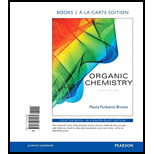
Concept explainers
Interpretation:
The steps for
Concept introduction:
Protein catabolism: It is defined as breakdown of proteins into smaller units that is into amino acids gets transported finally
Citric Acid Cycle: It involves 8 series reaction which converts acetyl group present in acetyl coenzyme A into 2
Substrate: The molecule where the reaction takes place with help of enzymes.
Enzyme: The proteins that helps
Oxidation: The oxidation is reaction that involves addition of oxygen atom or loss of electrons or removal of hydrogen atom present in the chemical compound.
Reduction: It involves removal of oxygen or addition of hydrogen to the chemical compound.
Coenzyme: They are non-proteins molecules which helps enzymes for catalyzing the reaction.
Want to see the full answer?
Check out a sample textbook solution
Chapter 24 Solutions
Organic Chemistry, Books a la Carte Edition (8th Edition)
- Step 7 of the citric acid cycle is shown. Which statement best describes what occurs in this step? CO₂ 1 CH || CH + H₂O CO₂ fumarate CO₂™ fumarase HO C-H CH₂ CO₂ malate A) Fumarate undergoes hydrogenation with hydrogens and electrons provided by the enzyme fumarase. B) Fumarate undergoes hydration with the aid of the enzyme fumarase. C) Fumarate undergoes hydrolysis with the aid of the enzyme fumarase. D) Fumarate undergoes reduction with the aid of the cofactor fumarase.arrow_forwardMost fatty acids have an even number of carbons and, therefore, are completely metabolized to acetyl-CoA. A fatty acid with an odd number of carbons is metabolized to acetyl-CoA and one equivalent of propionyl-CoA. The following two reactions convert propionyl-CoA into succinyl-CoA, a citric acid cycle intermediate, so it can be further metabolized. Each of the reactions requires a coenzyme. Identify the coenzyme for each step. From what vitamins are the coenzymes derived?arrow_forward
 Introduction to General, Organic and BiochemistryChemistryISBN:9781285869759Author:Frederick A. Bettelheim, William H. Brown, Mary K. Campbell, Shawn O. Farrell, Omar TorresPublisher:Cengage Learning
Introduction to General, Organic and BiochemistryChemistryISBN:9781285869759Author:Frederick A. Bettelheim, William H. Brown, Mary K. Campbell, Shawn O. Farrell, Omar TorresPublisher:Cengage Learning
 Chemistry for Today: General, Organic, and Bioche...ChemistryISBN:9781305960060Author:Spencer L. Seager, Michael R. Slabaugh, Maren S. HansenPublisher:Cengage Learning
Chemistry for Today: General, Organic, and Bioche...ChemistryISBN:9781305960060Author:Spencer L. Seager, Michael R. Slabaugh, Maren S. HansenPublisher:Cengage Learning General, Organic, and Biological ChemistryChemistryISBN:9781285853918Author:H. Stephen StokerPublisher:Cengage Learning
General, Organic, and Biological ChemistryChemistryISBN:9781285853918Author:H. Stephen StokerPublisher:Cengage Learning Organic And Biological ChemistryChemistryISBN:9781305081079Author:STOKER, H. Stephen (howard Stephen)Publisher:Cengage Learning,
Organic And Biological ChemistryChemistryISBN:9781305081079Author:STOKER, H. Stephen (howard Stephen)Publisher:Cengage Learning,




